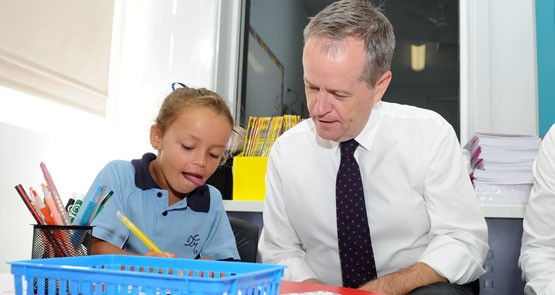
Labor has embraced genuine economic reform with its commitment to continue funding of the Gonski reforms beyond 2017. But it’s at the easy end of the economic reform spectrum. There are no losers from Labor’s proposal, no one to complain that they’ve missed out, no sectional interests unhappy with the outcome. The best the Coalition can say is that it’s unfunded, and that simply pumping money into schools doesn’t necessarily improve outcomes.
Not exactly an argument likely to resonate with parents.
The Coalition’s handling of education funding was one of the shabbier and more dishonest elements of their 2013 election campaign. When Julia Gillard was prime minister, the then-opposition had instantly dismissed the Gonski report and its proposed funding model, designed to more effectively target disadvantaged students by establishing a base per-student funding level with additional increments based on needs. That naysaying persisted right up until it became obvious it would be an electoral drawback to keep opposing it. Tony Abbott then turned on a dime during the election campaign and declared he was backing Labor’s funding proposals for four years. “As far as school funding is concerned, Kevin Rudd and I are on a unity ticket,” he announced, to the shock of his then-education shadow Christopher Pyne, who up until that very moment had been saying they’d only keep funding for one year. Pyne then had to adjust to the new Abbott position, saying “you can vote Liberal or Labor and you’ll get exactly the same amount of funding for your school”.
Once the Coalition was elected, the issue became the first of what would turn out to be a long litany of both broken promises and bungles, with now-minister Pyne announcing that the Gonski funding formula would be ditched in favour of an unspecified formula likely to involve a return to the discredited “socio-economic status” formula that resulted in the Howard government funding private schools grossly disproportionately. As it would come to do repeatedly, the government then backflipped on its backflip, and announced it would honour existing funding deals with the states for four years.
That left the issue of funding beyond four years hanging — hanging mainly over state government budgets, given state governments would either have to make up the shortfall in year five (2018) or slash schools funding.
The reality is that, if funding discontinues, state governments will take the easy option and let school funding fall or stay static for more disadvantaged students, while students from more politically powerful communities retain higher levels of funding. That would undermine the entire rationale of the Gonski funding framework, which is to direct more resources at disadvantaged students. It is their performance that has been the reason for Australia’s slide in international rankings.
As the government correctly says, it’s not clear that simply pumping more money into schools will produce better outcomes. But no politician is going to direct resources to disadvantaged students ahead of other students. The additional Commonwealth funding package put together by Julia Gillard, based on ensuring no school would be worse off and most schools better off, recognised the reality that disadvantaged students rank lower than other students in the electoral calculations of all politicians.
Improved outcomes for disadvantaged students will improve workforce participation and reduce welfare and health costs — quite apart from the civic and personal benefits to the students from disadvantaged backgrounds. It’s a long-term goal, something that requires many years of targeted funding, but it’s a genuine human capital economic reform, particularly if we’re to be as “innovative” and “agile” as Malcolm Turnbull wants us to be. It’s harder to be innovative if your education system is operating in second gear.
As the government was quick to note, there are no offsetting savings from elsewhere in the budget for what Labor says is a $37 billion package over a decade. Labor has already said it will go after multinational tax avoidance and reduce super tax concessions (both victimless crimes in the eyes of voters) as well as increase the tobacco excise (nearly as good as). Labor has also made the riskier commitment to reintroduce an emissions trading scheme. It’s to its credit that Labor has been upfront about its planned tax rises. But until we see a full allocation of saves and spends in Labor’s policy package, the accusation that the extra funding is coming straight from the deficit will linger.








Labor treats good ideas like women candidates,
only give them a go when you’re desperate.
PS: That’s still miles ahead of the other mob.
If Simon Birmingham thinks that spending more money isn’t the answer, then he won’t mind cutting the money to the wealthy, exclusive, selective, elitist private schools all of whom have upgraded their facilities from excellent to opulent since Howard decided they were disadvantaged.
The NSW education minister was on air this morning supporting the policy (although saying that the Coalition would manage the money better) and saying that the Gonski money had already done wonders in NSW.
I hope that the child in the pic was learning him good – he certainly needs to get his act, and it is purely an act, together.
Leave him alone AR, he’s streets ahead of the other bloke.
Jane… at what? He is an ideas & ethics free waste of space.